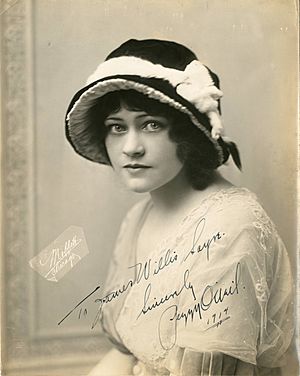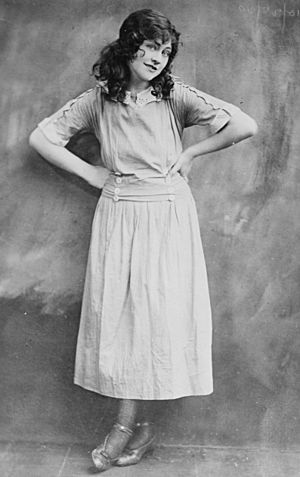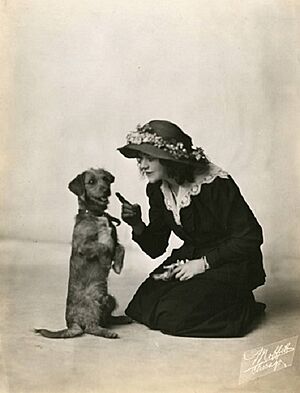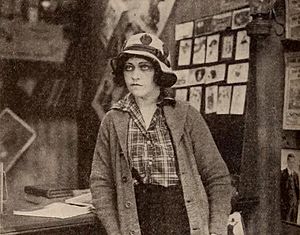Peggy O'Neil facts for kids
Quick facts for kids
Peggy O'Neil
|
|
|---|---|

O'Neil c. 1914
|
|
| Born |
Margaret O'Neil
16 June 1898 Gneeveguilla, County Kerry, Ireland
|
| Died | 7 January 1960 (aged 61) London, England, U.K.
|
| Occupation | Actress |
| Years active | 1913–1938 |
Margaret O'Neil (born June 16, 1898 – died January 7, 1960) was a talented Irish-American vaudeville actress. Vaudeville was a popular type of entertainment with many different acts, like singing, dancing, and comedy.
Contents
Early Life
Peggy O'Neil's family moved from Ireland to Canada around the year 1900. They soon settled in Buffalo, New York. Peggy went to a Loreto convent school.
When Peggy was nine, her father, Frederick, sadly died in a train accident. Her mother, Mary Buckley O'Neill, passed away three years later. Peggy was then cared for by her relatives. Her uncle, Charlie Zimmerman, was a music director. He saw Peggy's artistic talent and encouraged her to join theater choirs. He even cast her as a singer in a play called "The Sweetest Girl in Paris" in 1910. This was the first play at the newly rebuilt La Salle Theater in Chicago.
Acting Career
Peggy O'Neil acted in several plays. A big moment in her career came in 1919. A producer named Robert Courtneidge was looking for an "Irish actress with red hair" for a play in London. He met Peggy in the United States.
Peggy then traveled to London to play the main role of Paddy in Gertrude Page's play Paddy the Next Best Thing. She loved London so much that she decided to live there for the rest of her life. This decision meant she had to delay her engagement to an American millionaire named Joe Moran. For many years, she was a very popular actress on English-speaking stages.
In October 1920, Peggy O'Neil faced a dangerous incident. She received a box of chocolates that contained harmful substances. She survived the attack, but her dog sadly died. No one ever found out who was responsible.
In 1928, Peggy visited the National Radio Exhibition in London. There, she saw John Logie Baird's new invention: television! She was invited to sing some Irish songs on TV, which helped make the new invention more popular. Peggy O'Neil also became the first person ever to be interviewed on television. This interview happened in April 1930.
Peggy O'Neil also appeared in films. From 1913 to 1938, she acted in 23 movies. She had small roles in films like The Razor's Edge and Let's Dance. She even worked as a body double for famous actress Ingrid Bergman in the movie Joan of Arc.
Besides acting, Peggy was also a painter. She showed three of her oil paintings to the public at art galleries in London.
During the 1930s, Peggy O'Neil faced some tough times with money and her health. In 1935, she had financial problems.
Later Years and Passing
From the mid-1940s, Peggy O'Neil began to suffer from arthritic pain. This made it hard for her to leave her home, and she eventually needed a wheelchair.
Peggy O'Neil passed away on January 7, 1960, in London, due to heart failure. She was 61 years old. She was buried in the St Pancras and Islington Cemetery. The "Actors' Benevolent Fund," a charity that helps actors, paid for her funeral. However, there is no gravestone to mark her resting place. Peggy O'Neil never married and did not have any children.
Peggy O'Neil Song
In 1921, a popular waltz song called Peggy O'Neil was written by Harry Pease, Ed. G. Nelson, and Gilbert Dodge. The song became very famous and was sung by many different artists. The lyrics began with: "Peggy O'Neil is a girl who could steal any heart, anywhere..."
Theater Performances
United States
- 1910: The Sweetest Girl in Paris (at La Salle Theater, Chicago), as a child singer
- 1914: Peg O' My Heart (chosen from 400 young hopefuls)
- 1916: The Flame (at Lyric Theatre, Broadway)
- 1918: Patsy on the Wing (in Chicago)
- 1919: Tumble
- 1927: Ziegfeld Follies (at New Amsterdam Theatre)
Europe
- 1920: Paddy The Next Best Thing (at Savoy Theatre, London), playing the main role
- 1922: Kippers and Kings (at Theatre Royal, Dublin)
- 1924: The Little Minister (by J. M. Barrie)
- 1924: What Every Woman Knows (same as above)
- 1925: Mercenary Mary (by William B. Friedlander) (at Hippodrome, London)
- 1928: The Flying Squad (by Edgar Wallace; at Lyceum Theatre (London))
- The Sea Urchin (at Gaiety Theatre (Dublin))
- 1929: Paddy The Next Best Thing, a new showing (at Garrick Theatre (London))
- 1930: The Bachelor Father (same as above)
- 1930: When Dreams Come True (at Olympia Theatre, London), (at Theatre Royal, Birmingham), (at Gaiety Theatre, Dublin)
- 1931: Sisters, a Drama of Laughter, Tears and Romance
- 1934: No Surrender (at Theatre Royal, Brighton)
- Late 1930s: Meet my Wife
- 1943: They Gave Him a Gun (at Theatre Royal, Brighton), a war drama
- 1943: Tainted Gods (at Leeds City Varieties, Leeds)
Film Roles
Peggy O'Neil had small supporting roles in these films:
- 1945: The Unexpected Husband
- 1946: The Razor's Edge
- 1948: Joan of Arc (as a body double for Ingrid Bergman)
- 1950: Let's Dance
Images for kids








